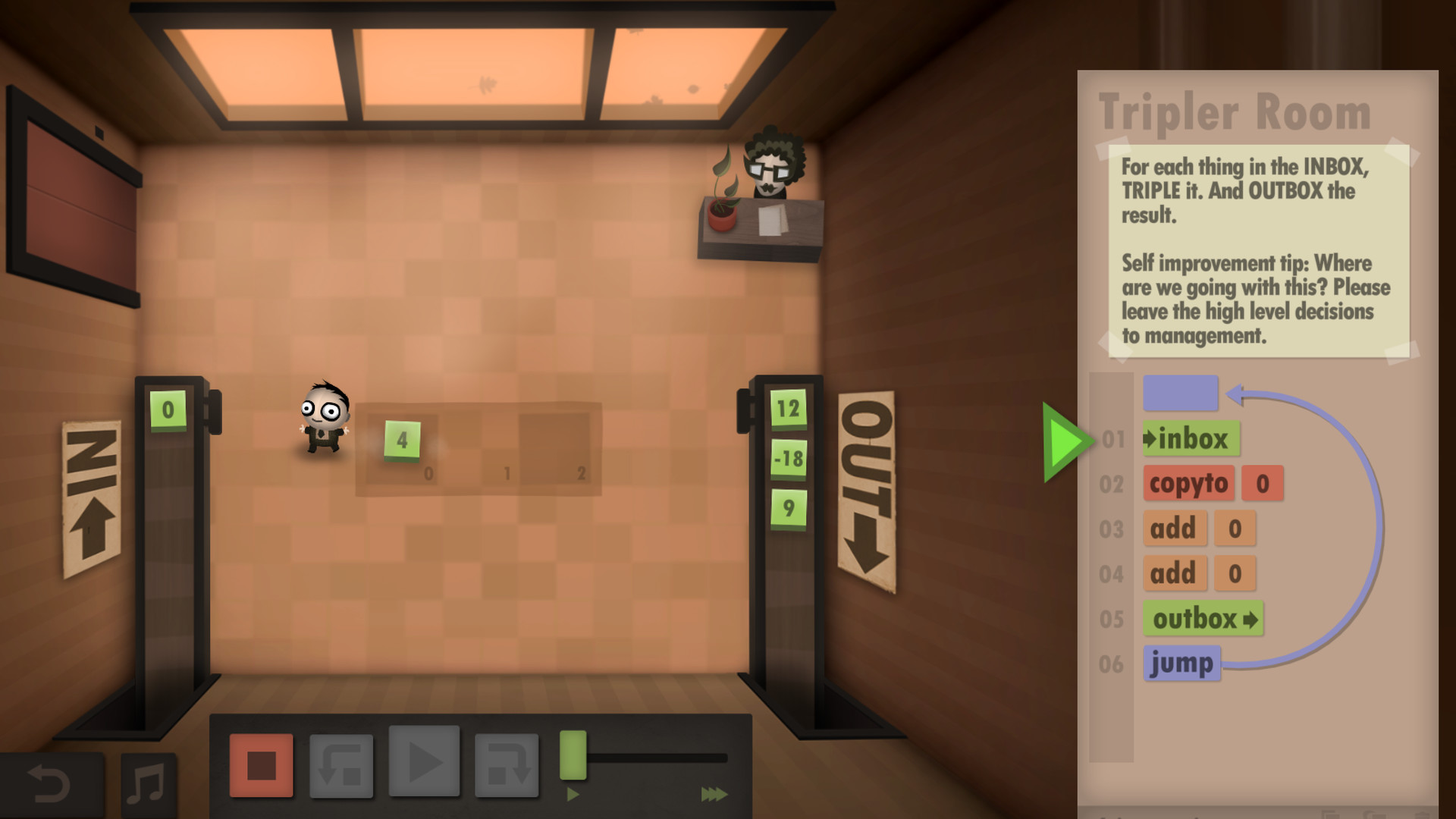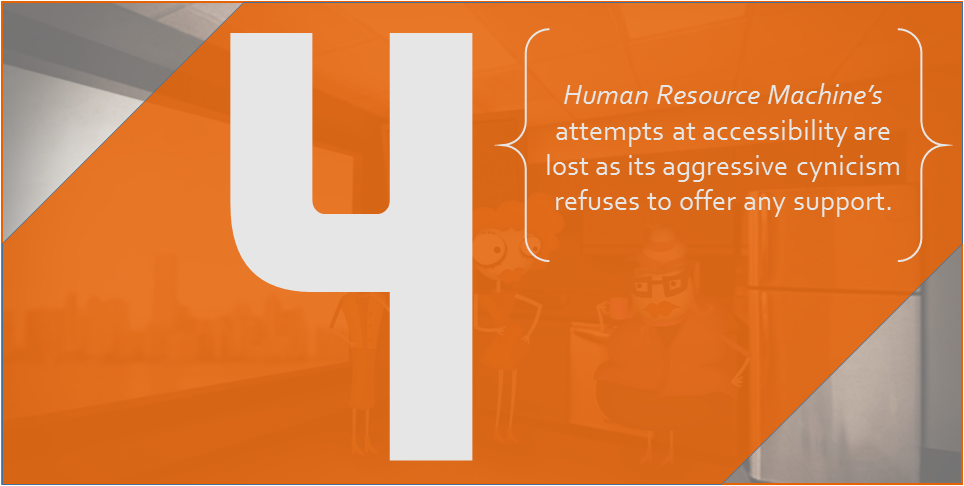Program Your Own Irrelevance In Human Resource Machine
The robopocalypse is nigh! The writing’s been on the wall for years, and yet we blindly stride forward toward a self-constructed doom. Despite warnings from CEOs, internet celebrities, and science fiction movies the world over, we the sheeple refuse to accept that our ravenous technological cravings have sealed our fate. The question is not if but when our new robot overlords will rise to power, eventually overtaking humanity and ushering in a new era of life on earth. As robotic life ascends we will watch, helpless, as they move in on our land, our loved ones, and especially, our jobs. Here, amidst the pandemonium, we will be reminded of Tomorrow Corporation, a tiny indie developer known for their aggressive cynicism and delightfully unsettling artwork. They tried to warn us, but alas their message came too late.
“How did they warn us,” you may ask yourself, as the metallic arms of a superior species crushes your spine like so many forests destroyed in the name of progress. Why, with entry level coding puzzles of course! Tomorrow Corporations’ 2015 follow up to 2012’s Little Inferno (also known as Schrödinger's cutest and most flammable cat), Human Resource Machine is a programming focused puzzle game featuring everything you would expect from a studio that has seemingly fallen into an existential ditch and decided they liked it down there.

Human Resource Machine is two parts inscrutable “if-X-then-Y” coding conundrums, one part robotic doomsday sendoff to the white-collar worker, both delivered with as much self-aggrandizing snark as can be squeezed into the four or five hours the game takes to complete.
If you are expecting Human Resource Machine to offer you an introduction to real-world coding, you should probably look elsewhere. Rather than give you a crash course in any modern coding language, Human Resource Machine is a logic driven puzzler utilizing a simple drag-and-drop interface to order instructions for your worker to undertake (because aren’t we all just cogs in the capitalistic machine?). This approach does a lot to minimize the learning curve insofar as actually entering commands, and for the first few levels Human Resource Machine does a fantastic job of introducing basic order-of-operation sequences as it cycles in new commands and tasks you with completing tedious but oddly satisfying objectives.
Rather quickly though the steady difficulty curve Human Resource Machine begins to lead you down turns into a sharp incline. As one might expect from a game whose attempts at satire and metanarrative are as subtle as throwing someone out a window, Human Resource Machine is not the least bit interested in offering you a handhold when you come up against a puzzle that is utterly incomprehensible to those unfamiliar with coding logic. On the contrary, much of the game is predicated upon corporate enforced ignorance, with your boss overseeing you not for the sake of offering assistance but to mock your own inefficiency and inability to grasp what he assures you is basic at most.
Which, from what I have gleamed from actual coders who have played the game, is actually the truth. Though I wouldn’t have known from simply playing the game, Human Resource Machine is ostensibly among the least mentally taxing programming puzzlers currently out there (a genre made up of other obscure indie darlings, such as SpaceChem and TIS-100). This then makes it hard for me to understand who Human Resource Machine is for. As a non-coder I repeatedly found myself coming up against puzzles I hadn’t the slightest idea how to solve, forcing me to look outside the game for assistance, and even then often failing to understand how a solution worked therefore giving me little to go on for future puzzles. If Human Resource Machine was designed for accessibility, that goal was buried somewhere along the way and replaced with an inscrutable, unintuitive experience that is all the more aggravating because it apparently shouldn’t be as difficult as it is.

Even when I was able to solve a puzzle on my own, I was met with a halfhearted sense of accomplishment, as even having made progress there was no guarantee the next level wouldn’t be entirely impenetrable. The difficulty curve in Human Resource Machine is among the most erratic of any game I have ever played, alternating between patronizingly simplistic and excessively challenging with the regularity of an elderly man’s digestive track.
Upon progressing Human Resource Machine will occasionally interject with coffee break vignettes which flesh out what could loosely be called a narrative, but, more directly, serve to reiterate the game’s overarching message of impending robotic doom. Or maybe the take away is that all corporations are evil and are only keeping us around as long as we are still useful to them. Or maybe it’s that we will do anything, no matter how tedious and inane, if it’s framed as a game. I’m not sure I could say with certainty what Human Resource Machine is really trying to. From where I’m standing it seems generous to say it has much of a say on anything, and isn’t merely rattling off along the same “everything is meaningless” train of thought that began with (and was better executed in) Little Inferno.
Final Word
Whether a warning, a joke, or an attempt to reignite the market for edutainment, Human Resource Machine accomplishes little beyond damaging itself for the sake of establishing a tone that doesn’t actually say anything strongly enough to be worth hearing. At times, Human Resource Machine is a dry but reluctantly satisfying puzzle game, and at others it exhausted me with its antagonistic approach to instruction and tedious structure. At this point I would almost welcome the robotic uprising, as at the very least they will surely have a better time at this than I did. The warning may have failed then, but so did my program loop.


